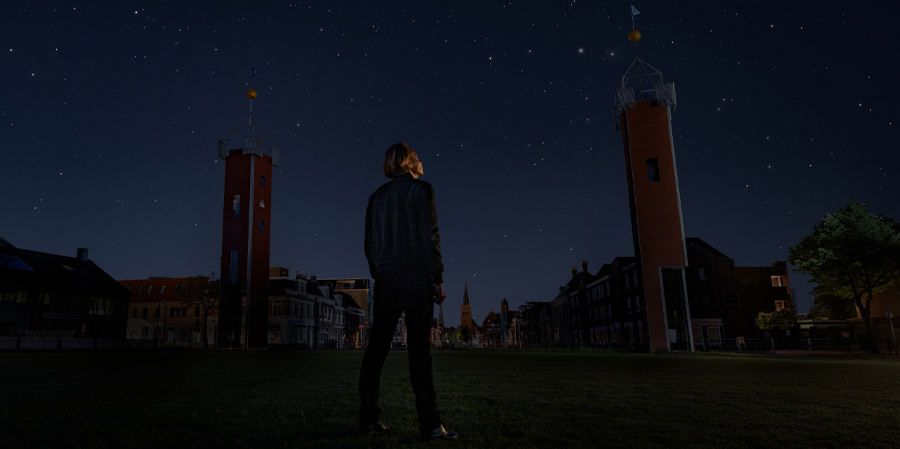When the city of Franeker, Netherlands, turned off its lights for a night to reveal the now-rarely seen splendor of the night sky, it was a reminder of our inextricable link to each other and our universe.
Less than a hundred years ago, people could look up on any given night and be treated to an enchanting light performance, courtesy of the stars. But as the years — and “civilization”— progressed, 80 percent of the population now live in cities, under a blanket of light pollution that hides the celestial light show each night.
But, as simple as it is to turn a light on, we can turn it off. With this in mind, designer and artist Daan Roosegaarde and UNESCO Netherlands conceived their Seeing Stars project — in which the city of Dutch city of Franeker would be gifted back a view of its skies for a night. Safety measures in place, the city turned off its lights and the light pollution was removed — allowing the dazzling night sky to reappear.
“In a world of lockdowns and COVID restrictions, people feel disconnected and have lost a sense of hope,” Roosegaarde told Sustainable Brands™. “Seeing Stars pushes for a radical movement — not just about the darkness, but also inspiring a sense of community that has been under attack.”
As human beings, we can often forget how connected we are to each other and to our universe. This has been exacerbated by the pandemic — which has divided loved ones, cities and countries, increasing our feelings of dissonance. This isn’t Roosegaarde’s first effort to create opportunities for people to reconnect — the Studio’s 2021 Urban Sun project is a light installation designed to clean public spaces of the coronavirus.
According to the International Dark-Sky Association, while artificial light at night has revolutionized the way we live and work outdoors, it has come at a price. When used indiscriminately, outdoor lighting can disrupt wildlife, impact human health, waste money and energy; and contribute to climate change, in addition to blocking our view of the galaxy. And this isn’t the first initiative aimed at bringing back the darkness – the 2007 Declaration in Defense of the Night Sky, The Netherlands’ Nacht van het Wad park and annual Nacht van de Nacht (“Night of the Night”), and even Earth Hour encourage us to turn off the lights and look up, to soak up the peace of a star-filled sky.
The Seeing Stars event happened in June. Franeker was chosen due to its rich history with astronomy and hosting the famous Royal Eise Eisinga Planetarium. The importance of the dark sky and the science of stars was a way to reconnect Franeker with its astronomical heritage. And although Roosegaarde’s dream to turn off the lights may seem simple, it involved the coordination and participation of the whole city.
UNESCO Netherlands recognizes observing stars as a universal right and a way for people to reconnect with the world around them.
“At UNESCO, we want to connect people through everything that unites us — to create peace in people’s minds,” Kathleen Ferrier, Chairperson of the Netherlands Commission for UNESCO, told Sustainable Brands. “Seeing stars together and witnessing the cosmos creates such a connection and inspires thoughts of peace. That is why we fully aligned the importance of this project and whenever possible, will stimulate other cities to put out the light.”
Studio Roosegaarde is working to bring Seeing Stars to other interested cities such as Leiden, Sydney, Venice, Stockholm and Reykjavik.
“I fully encourage other cities, governments, mayors to have this experience for themselves,” Ferrier said. “It has a huge psychological and emotional effect on people — and that’s exactly what people need in these times.”
In our overstimulated world, people are bombarded by light, noise and other stimuli. Roosegaarde asserts that — instead of building and adding to a broken, overstimulated system — designers and architects should look to what can be removed in order to improve our lives and experience.
“We often talk about smart cities, AI, self-driving cars; but Seeing Stars should be part of a ‘smart’ city — it’s an experience that brings out and connects us with a primal feeling,” Roosegaarde said. “Seeing Stars is an example of how you can curate or edit something in a better way to get something back; in our case, it was the stars — which have been there for millions of years. I hope it will advocate people to feel more connected with the future, instead of feeling trapped or isolated.”
…
This article first appeared in www.sustainablebrands.com
Seeking to build and grow your brand using the force of consumer insight, strategic foresight, creative disruption and technology prowess? Talk to us at +971 50 6254340 or mail: engage@groupisd.com or visit www.groupisd.com/story



